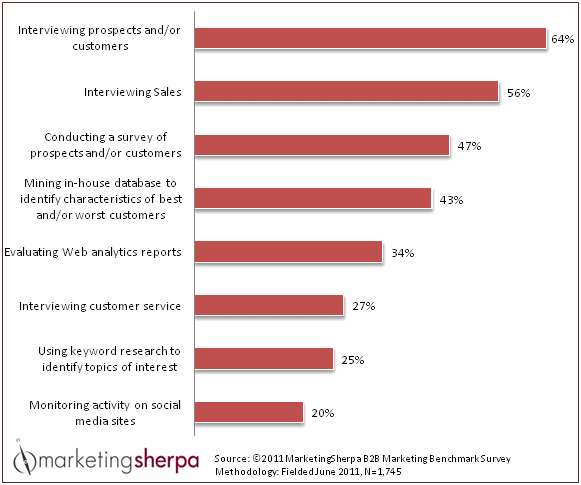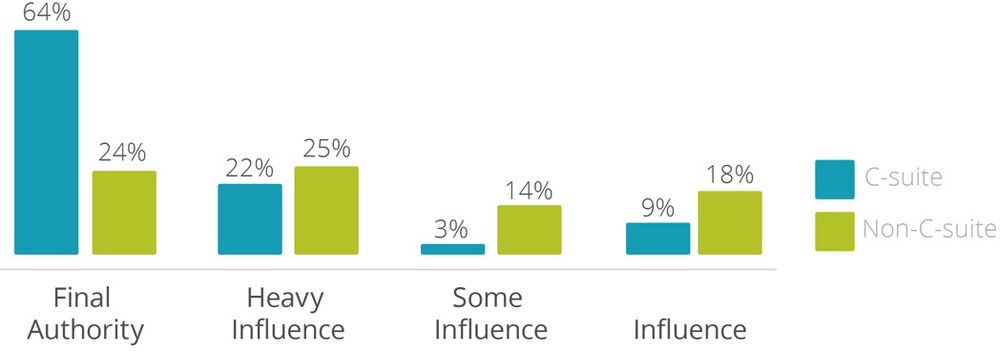Develop Better B2B Buyer Personas: 4 Steps to Using SEO Insights to Create Effective, Data-Driven Personas [Worksheet]
Driving conversions in B2B marketing requires content that caters to multiple decision-makers at every stage of their unique buyer journeys. It’s not just executives who make purchase decisions: 81% of mid-level managers and individual contributors also have a say. This makes the development of B2B buyer personas critical, yet 47% of B2B organizations do not have them.
The complexity of persona development causes many B2B marketers to do a “good enough” job, or abandon the exercise altogether. For each product, service, or even feature, multiple personas must be defined to account for numerous decisions-makers with different titles and various goals. That complexity is further amplified by the processes commonly used for definition: interviewing customers and team members, mining databases, and monitoring social media.
Research methodologies used by marketers when defining buyer personas.
Using strategic SEO research, marketers can simplify and improve persona development. The insights gathered during SEO research lead to detailed buyer personas that, in turn, guide engaging and revenue-generating content strategies.
Make sure to get a copy of our B2B personas worksheet at the bottom of this post to help you organize and implement your new insights!
1. Gather Initial Insights from Keyword Research
The SEO process of keyword and user intent research provides valuable insights into who B2B decision-makers are, what role they have at their companies, what types of information they’re seeking, and how they’re searching for that information. Those insights can then be used to create detailed buyer personas for each company offering.
Your initial, or existing, keyword list can already provide general insights into who is searching for your product and what they’re seeking to do with it, if you know how to look.
For example, keyword research for the term “content management systems” provides a variety of related keywords:
- content management systems for schools
- content management systems for small businesses
- news content management systems
- ecommerce content management systems
These keywords tell a marketer which industries active prospects may work in. Additionally, the initial list of keywords provides insight into common use cases for content management systems:
- content management systems for websites
- forum content management system
- newsletter content management system
- publishing content management systems
Just an initial scan of keywords gathered in the research process provides valuable insights, but remember to Google them for user intent before you spend much time on them. Some of the above result in a lot of organic listings for CMS newsletters and discussion forums — not necessary relevant for a CMS software provider.
A company that sells CMSs may have prospects that come from industries such as education, SMB, media and entertainment, and retail. And those customers may be looking for solutions to build and manage websites, publish content online, send newsletters and marketing emails, and build forums and communities.
2. Segment Keywords into Related Groups
The next step is segmenting the keywords into groups based on which product, service, feature, task, or industry they relate to:
- Industry Groups: A keyword list for “content management systems” may include multiple keywords related to the education industry. Keywords like “content management systems for education,” “content management systems for schools,” and “higher education content management systems” would all be grouped into a single industry segment.
- Product Groups: The same company may sell both customer-facing CMSs and intranet systems. Keywords like “content management systems for websites” and “web publishing systems” could be grouped together because they’re relevant to the customer-facing product.
- Feature Groups: Group keywords by the feature they belong to. For the publishing feature of the CMS, grouped keywords could include “editorial content management system,” “publishing content management solution,” and “web publishing systems.”
- Service Groups: A digital marketing agency may group keywords by services offered. For content marketing services, the keyword group may include “content marketing companies,” “content marketing for lawyers,” and “B2B content marketing.”
Keywords that apply to the overall business and not a specific aspect should be placed in a general group. Additionally, it’s fine to include a single keyword in multiple groups if it applies to more than one.
3. Segment Keywords into Decision-Maker Groups
The next step is to turn to Google to gather valuable insights about who your decision-makers are, what types of information they’re interested in, and what words they’re using to find that information.
At a minimum, there are three types of decision-makers in the B2B purchasing process: researchers, influencers, and final authorities.
- Final authorities are often executives. They provide sign-off on purchases and are concerned with high-level strategic items like cost, ROI, and overarching business problems. They’re looking for thought-leadership, features, and/or prices.
- Influencers are often individual contributors who are most concerned with how a solution is going to help them complete day-to-day tasks more effectively or efficiently. They’re looking for a brand that speak their (sometimes very technical) language and provide actionable insights and answers.
- Researchers are commonly mid-level managers whose goals lie somewhere in between executives and individual contributors. They want to make their teams more effective and efficient as a means of supporting overall company goals and growing revenue. They’re often looking for third-party comparisons, price charts, etc.
Nearly one-fourth of managers and individual contributors have the final say in purchasing decisions. Almost half of all B2B purchases are either heavily influenced or made by decision-makers outside of the C-suite.
Start with one persona for each of these decision-makers, and then conduct depersonalized searches for each keyword on your list.
Because 71% of B2B researchers start the process with a generic search, the keyword group of general terms is a good starting point.
After searching for a keyword, review content of the page-one results Google provides. A search for the general term “content management systems” populates introductory content and lists of different CMSs. Most likely, this is a keyword used by a researcher seeking to learn more about the topic and find potential solutions.
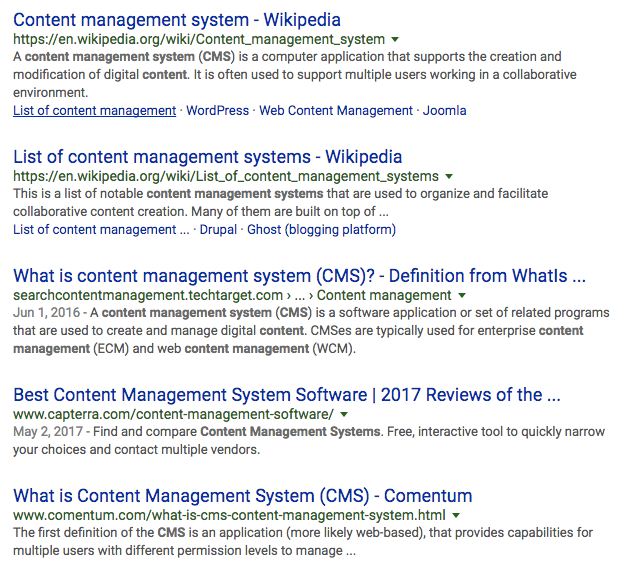
A search for “cloud content management systems” produces blended results—some system comparisons and some landing pages that use highly technical language. This suggests that the keyword is used by both researchers and influencers.
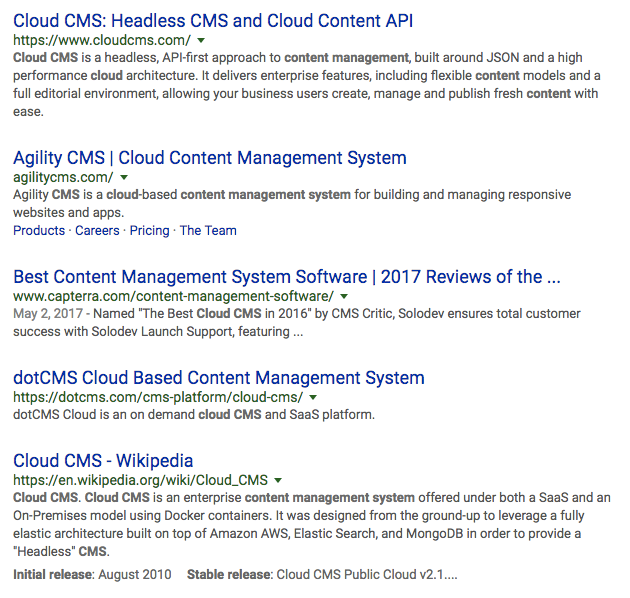
The keyword “cost content management system” results in pricing guides and thought leadership pieces, suggesting that it’s used by final authorities.
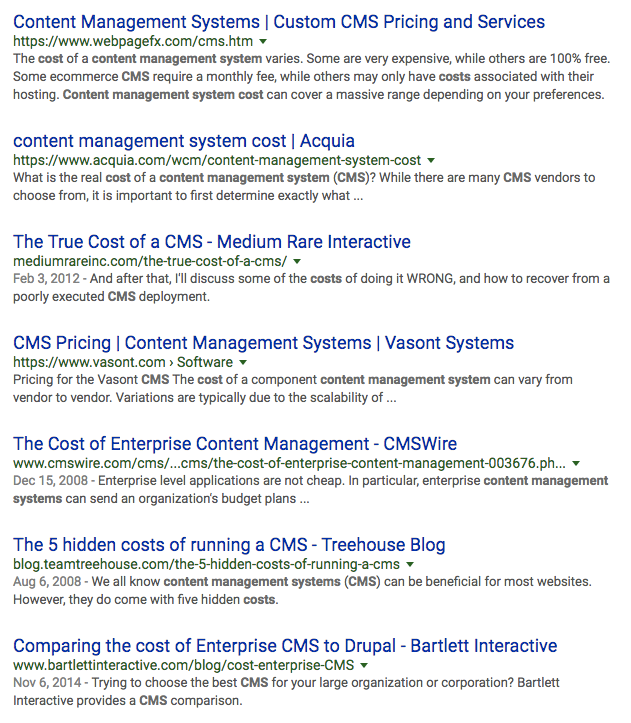
The results for the keyword “light content management systems” all use technical language, so it can be attached to the influencer persona.
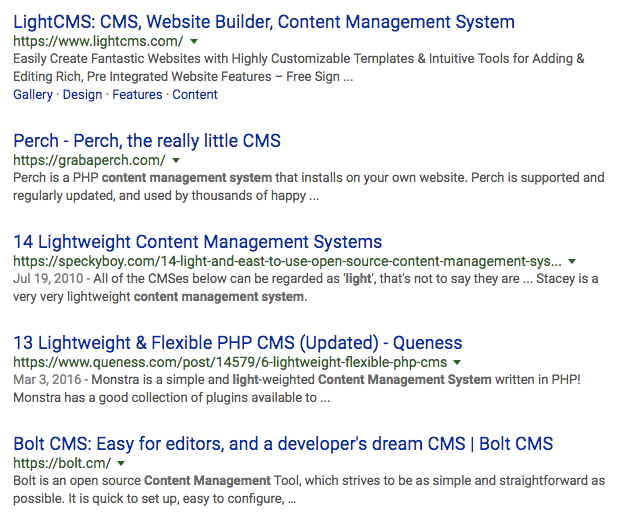
Conduct this exercise for all keywords on the list, and then filter the list by decision-maker. The final list provides significant insight into what information different decision-makers are interested in, and how they’re searching for that information online.
For example, let’s assume the list of general keywords that you assigned to influencers were as follows:
- cloud content management systems
- light content management systems
- metadata and content management systems
- taxonomy and content management systems
- content management systems net
- component content management systems
- api content management systems
- perl content management systems
This tells you that influencers who are comparing solutions are interested in learning more about different CMS technologies, understanding how a new CMS will integrate with existing services, and finding a CMS that is built to handle specific programming languages.
That information can be used to develop a detailed, and accurate, buyer persona.
Then, take it a step further and conduct the same exercise for the group segmented by industry to define more details about researchers, influencers, and final authorities in different industries—or who are interested in specific products, services, and features.
4. Use Personas to Customize Content for its Real Audience
With personas defined, content can be catered to the individual needs, pain points, and goals of the real audience. The keywords you researched and segmented can be used as the basis for generating ideas for new content, and the personas can be reviewed to ensure all content — new or existing — speaks to the right people.
Learn what two years of research taught us about SEO for tech brands →
If you pulled your list of keywords from Google Search Console, you can review the content that those keywords point to and make sure existing content speaks to the right audience. If not, take time to update the content and address the appropriate audience.
Developing and Refining B2B Buyer Personas with SEO
With SEO research, B2B marketers can gather data-driven insights to create buyer personas and validate the findings of more traditional research methods. With detailed personas in hand, new and existing content can be targeted and personalized to engage the appropriate audience.
Even an initial exercise to develop three personas—the final authority, researcher, and influencer—with general business keywords is a great starting point for personalizing content. Then, expand those personas over time, using both keyword research and traditional methodologies.
Get started by using the form below to get a copy of our exclusive B2B Buyer Persona Worksheet. It will help you track and organize your insights, and turn them into highly targeted, effective content ideas.

What's Next?
Profound Strategy is on a mission to help growth-minded marketers turn SEO back into a source of predictable, reliable, scalable business results.
Start winning in organic search and turn SEO into your most efficient marketing channel. Subscribe to updates and join the 6,000+ marketing executives and founders that are changing the way they do SEO:
And dig deeper with some of our best content, such as The CMO’s Guide to Modern SEO, Technical SEO: A Decision Maker’s Guide, and A Modern Framework for SEO Work that Matters.
